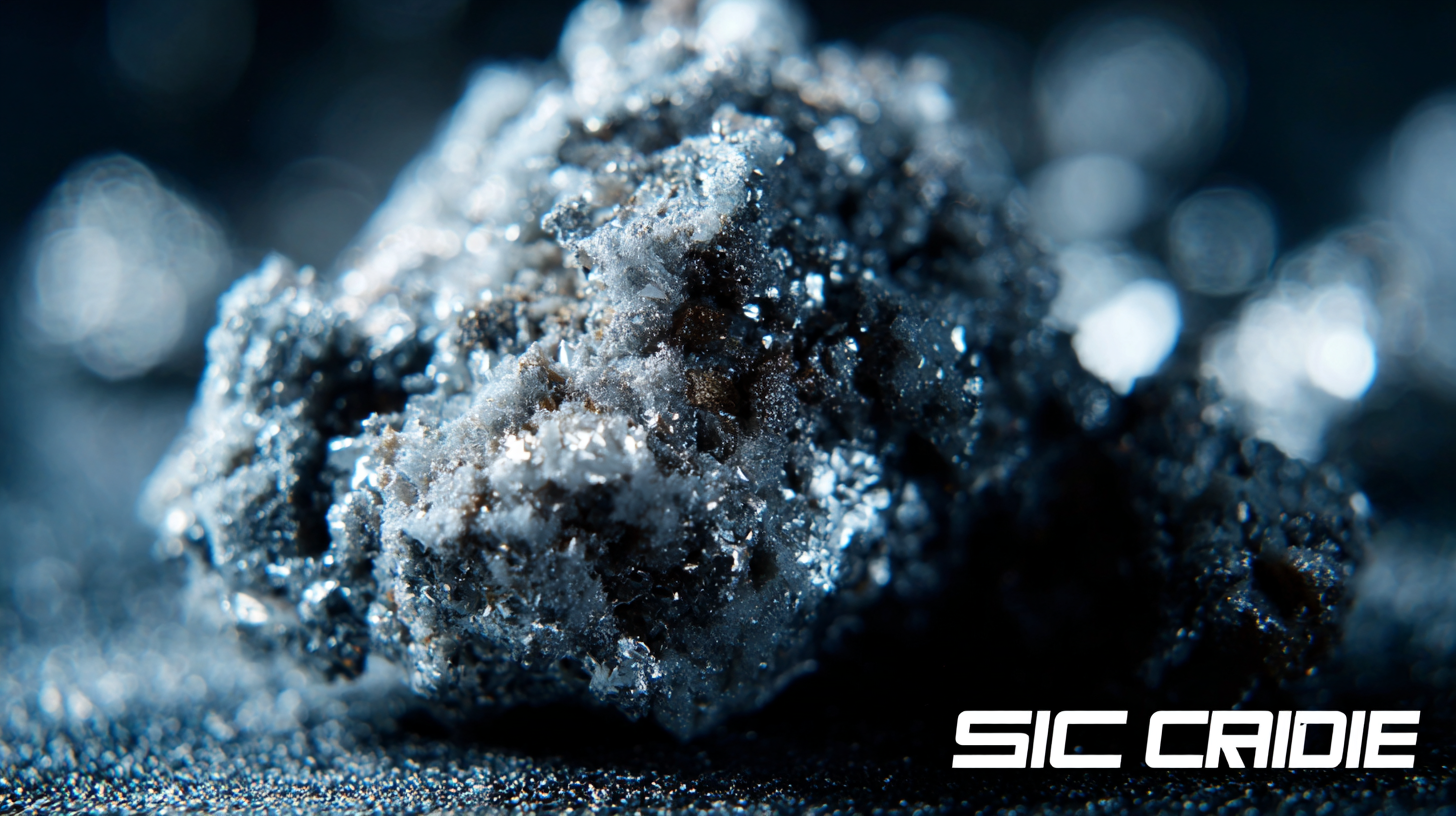Leave Your Message
In the rapidly evolving landscape of high-performance applications, the demand for materials that can withstand extreme conditions has never been higher. Sic Silicon Carbide has emerged as a frontrunner in this sector due to its exceptional thermal conductivity, mechanical strength, and electrical efficiency. According to a recent industry report by MarketsandMarkets, the Silicon Carbide market is projected to reach USD 3.42 billion by 2025, growing at a CAGR of 19.67% from 2020. This growth is driven by the material's versatility in various applications, including power electronics, automotive, and telecommunications.

With its unique properties, Sic Silicon Carbide not only enhances performance but also increases reliability, making it an indispensable choice for engineers and manufacturers aiming to push the boundaries of technology. In this blog, we will explore seven compelling reasons why Sic Silicon Carbide should be your preferred choice for high-performance applications, along with insights into its diverse product characteristics and appropriate usage scenarios.
Silicon carbide (SiC)
stands out as a superior alternative to traditional semiconductors due to its remarkable properties, which make it an ideal choice for high-performance applications. One of the most significant advantages of SiC is its
higher breakdown voltage, which allows devices to operate at higher power levels without succumbing to electrical stress. This characteristic is crucial in applications such as
electric vehicles and industrial systems, where efficiency and reliability are paramount.
Moreover, SiC exhibits higher thermal conductivity compared to conventional semiconductors, enabling better heat dissipation in devices. This property becomes increasingly important as power densities rise in modern technology. The ability to operate at elevated temperatures enhances the durability and performance of SiC-based devices, making them a favorable option for demanding environments. Additionally, the
higher operating frequency of SiC devices contributes to improved efficiency in power conversion applications, further solidifying SiC's position as the material of choice for engineers and manufacturers looking to push the limits of performance.
 Silicon carbide (SiC) has rapidly become a cornerstone in high-performance applications, particularly due to its exceptional thermal efficiency. In environments subjected to extreme conditions, SiC's ability to withstand high temperatures and manage thermal conductivity sets it apart from traditional materials. This heat resistance means that systems can operate at elevated temperatures without significant risk of failure, thereby enhancing overall reliability and performance.
Silicon carbide (SiC) has rapidly become a cornerstone in high-performance applications, particularly due to its exceptional thermal efficiency. In environments subjected to extreme conditions, SiC's ability to withstand high temperatures and manage thermal conductivity sets it apart from traditional materials. This heat resistance means that systems can operate at elevated temperatures without significant risk of failure, thereby enhancing overall reliability and performance.
Furthermore, SiC's superior thermal conductivity allows for efficient heat dissipation, which is crucial in high-performance environments such as power electronics and electric vehicles. This characteristic not only minimizes heat build-up but also contributes to increased operational efficiency. As a result, devices made with SiC can achieve higher power densities, leading to smaller, lighter components that do not compromise on performance. The thermal efficiency of SiC translates into longer lifespans and lower maintenance costs, making it the ideal choice for industries striving for peak performance.
When it comes to high-performance applications, durability and chemical resistance are paramount. Silicon carbide (SiC) stands out as a superior material in these areas, surpassing many competitors. Known for its exceptional hardness and high thermal conductivity, SiC can withstand extreme conditions without degrading, making it ideal for use in harsh environments. This resilience ensures longevity, reducing the need for frequent replacements and thus lowering overall operational costs.

Moreover, SiC demonstrates remarkable resistance to chemical corrosion. Unlike conventional materials, which can deteriorate when exposed to acids, bases, and other harmful substances, silicon carbide maintains its integrity even in the most challenging chemical settings. This characteristic not only enhances the reliability of equipment but also ensures safety, making SiC the preferred choice in industries such as aerospace, automotive, and semiconductor manufacturing. By choosing SiC, businesses can invest in materials that not only perform exceptionally well but also reduce maintenance challenges over time.
Silicon carbide (SiC) stands out as a game-changer in high-performance applications, particularly due to its long-term cost-effectiveness. One of the most significant advantages of SiC is its remarkable thermal conductivity, which allows for efficient heat management in various demanding environments. This property leads to enhanced reliability and reduced maintenance costs over the lifecycle of the components, thereby improving the overall return on investment (ROI) for users.
When considering SiC for your applications, it's essential to evaluate the total cost of ownership. While the initial investment might be higher compared to traditional materials, the durability and longevity of SiC components mean fewer replacements and less downtime. In addition, SiC's efficiency in power conversion can lead to substantial savings on energy bills, making it a wise choice for industrial and commercial applications alike.
Tip: Always compare the life expectancy of SiC devices with their counterparts. This assessment could reveal significant savings opportunities, highlighting why SiC isn't just a choice; it's an investment in future cost efficiency. Consider using established benchmarks to quantify performance gains in your specific applications, ensuring you optimize resource allocation effectively.
Silicon carbide (SiC) is rapidly gaining recognition as a cornerstone of energy efficiency and environmental sustainability in high-performance applications. The material's superior thermal and electrical properties make it ideal for cutting-edge technologies such as photovoltaic-thermal (PVT) collectors. Recent experimental studies have shown that integrating silicon carbide nanoparticles into thermal pastes can significantly enhance the performance of PVT systems, enabling more efficient energy conversion and reducing reliance on fossil fuels. This is particularly vital as the global shift towards sustainable energy solutions intensifies.
Furthermore, the environmental benefits of SiC extend beyond energy production. Notably, silicon carbide membranes are being developed for oily wastewater remediation, showcasing the material's versatility in tackling environmental challenges. These membranes provide an effective solution to mitigate pollution in industrial processes, thereby supporting sustainability goals. The silicon carbide fiber market is projected to grow from USD 3.41 billion in 2025 to an estimated USD 9.39 billion by 2034, underscoring the increasing demand for sustainable materials that facilitate energy efficiency and reduce greenhouse emissions. As industries continue to innovate with silicon carbide, its role in fostering a greener future becomes increasingly critical.
| Reason | Impact on Energy Efficiency | Environmental Sustainability |
|---|---|---|
| High Thermal Conductivity | Reduces energy loss during heat transfer. | Minimizes waste heat, reducing environmental impact. |
| Superior Power Density | Allows for smaller devices with higher efficiency. | Less material usage contributes to sustainability. |
| High Voltage Tolerance | Enables energy systems to operate at higher voltages. | Reduced need for infrastructure, lowering carbon footprint. |
| Enhanced Reliability | Improves lifespan and reduces energy waste over time. | Minimizes e-waste generation and resource consumption. |
| High Efficiency | Maximizes output with minimal power input. | Promotes renewable energy sources and grid stability. |
| Wide Bandgap Properties | Allows operation in extreme conditions with reduced energy loss. | Facilitates use in eco-friendly applications. |
| Lightweight Design | Contributes to lower fuel consumption in transportation. | Reduces material waste and promotes efficient recycling. |
